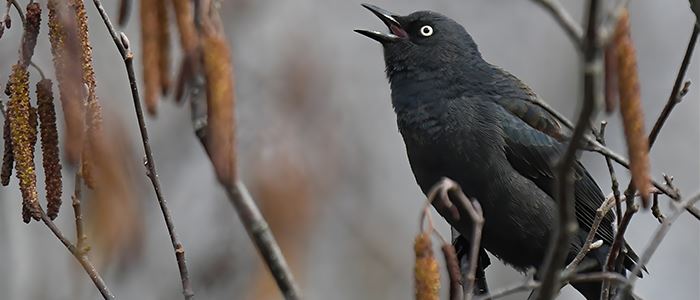A Rusty Reveal

By Karen Menard
It was a high-pitched, grating “creak” from the top of the tallest tree that captured my attention.
A lone, elusive blackbird awkwardly intertwined soft “chuck” calls, with sounds resembling a squeaky gate hinge, mixed with a quick trill similar to the sound of an old cassette tape being rewound.
Its calls mimicked a red-winged blackbird; but with closer inspection, in the gleam of the setting sun, a yellow jewel of an eye was revealed. Not a red-winged blackbird this time, but a rusty blackbird—an animal sometimes encountered only during spring and fall migration in the Toledo area. Its squeaky, “rusty” gate hinge calls were the real give-away, along with the yellow eye.
This individual was using Fallen Timbers Battlefield for prime migratory stopover habitat during the journey north from the southeastern U.S. to its breeding grounds in the boreal forests of Canada. Good stopover habitat offers sufficient food, water, and shelter for birds and is critical for a successful journey.
At Metropark sites like Fallen Timbers Battlefield, swampy stands of cottonwood trees and wet forest edges provide good opportunities for blackbirds to easily find insects and other tasty invertebrates submerged under fallen leaves. Recent studies have actually identified the nearby, Lake Erie marsh region as one of the most important stopover sites for this species in the Midwest.
Look for rusty blackbirds moving with other mixed flocks of blackbirds at Pearson and Howard Marsh Metroparks during spring and fall migration. They are most often drawn to areas with water.
Did You Know?
The rusty blackbird has been experiencing extensive, long-term declines. To learn more, go to: https://rustyblackbird.org/